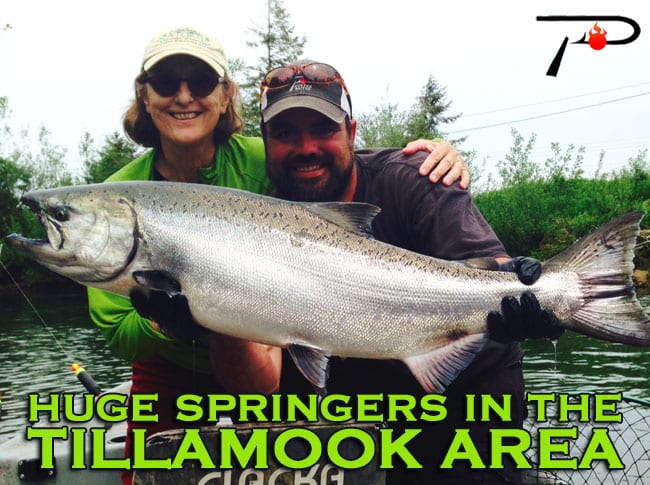Spawn
Huge Springers In the Tillamook Area
By Big Dave Manners | 05/26/2014
If you want big springers it’s going to be a challenge to find larger springers anywhere in the Northwest than what we have here in the Tillamook area. Our springers are much larger than the Columbia and Willamette fish. We get lots of 20 pound spring salmon, and the occasional that’s 30. These are big springers, but we have to work our butt off to catch fish this time of year.

It’s one of the few times of year that the fish you catch will be worth more than your guided trip. These are the best tasting and eating salmon. They go for $20-30 a pound locally, and $50 a pound back east. It’s rare for the fish you catch to be worth more than the guide fee, but that’s the deal around here right now.
For us, springer fishing has started a few weeks ago. Most of these fish are super bright fish with sea lice on them. Let’s remember, however, there was a few more fish early this year than we are accustomed to. Meanwhile, by early May there was fish moving into all of our local systems and some big ones, too.
![Tblog1-image[1]](https://www.pautzke.info/wp-content/uploads/2015/12/Tblog1-image1.jpg)
Right now there are springers everywhere from the ocean, through Tillamook Bay and through the river systems, including the Wilson, Trask, Nestucca and others. So far, our run is good. Right now, it’s about par with last year, which means there’s good numbers of fish around. Springer fishing goes good till late June in the Tillamook area. Sometimes it can get slow in the middle of June, but there’s always fish around.
In Tillamook Bay you’re trolling herring, some KwikFish and spinners, but I’m pretty much fishing the tidewaters and rivers solely. In those areas I’m doing a lot of bobber and egg fishing, back bouncing, using diver and bait and also a few plugs.
In the tidewaters you’ll need to adjust bobber depth often. On the incoming tide sometimes the fish will be suspended off the bottom. On the other hand, at low tide they are usually close to the bottom. If you are running multiple rods try to keep your depths at different levels until you find the fish.

In the river, where I concentrate most, your slow moving holes are going to be best for bobbers, but if it has more flow and it’s deeper you’ll want to back bounce. Right now, I’m soaking my eggs in red Fire Brine and adding red Fire Cure in my brine. I’m also adding Liquid Krill into my brine. I’m mixing all this in Ziploc and letting it sit for 24 hours and then draining it. After I drain it then I add red Nectar and let it soak that up. The reason why I use the Nectar, too, and spend so much time curing eggs is they’ll absorb the Nectar and plump up within 24 hours. I really think the Nectar is key and most people still haven’t realized that’s what all us guides are using.

Editor’s Note: Anglers can keep two hatchery fish per day in the Tillamook area. For more info on Big Dave’s Tillamook springer trips please visit http://www.bigdavesfishing.com/ or http://www.wilsonriverlodge.com/.
 [/fusion_builder_column][/fusion_builder_row][/fusion_builder_container]
[/fusion_builder_column][/fusion_builder_row][/fusion_builder_container]






